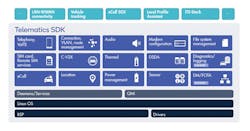Connected-Car Platform Supports Development of Cloud Digital Services
One of the huge challenges for system designers is anticipating how automotive platforms not yet built can accommodate circuitry not yet invented. Although these future solutions aren’t yet visible to the eye, teams are devoting much attention to ensuring that system functionality as well as utility are adaptable enough to support what may be unavailable today, but commonplace in the near future.
For instance, to meet the increasing demand for connected in-vehicle services, Qualcomm has introduced new solutions to its Snapdragon Digital Chassis connected-vehicle platforms. By adding Car-to-Cloud Services—Connectivity-as-a-Service—the company is supporting out-of-the-box connectivity, integrated analytics, and a cloud and device developer environment aimed at delivering new technology features, content, and services.
As integral components of the Snapdragon Digital Chassis, the Snapdragon Auto Connectivity Platform and Snapdragon Car-to-Cloud Services will help engineers build connected and intelligent vehicles that are safer, customizable, immersive, and continually upgradable.
Qualcomm also introduced an integrated application framework for developing telematics and cloud-connected applications and services, dubbed the Snapdragon Telematics Applications Framework. In addition, a new Wi-Fi 6E automotive chipset is engineered to increase bandwidth for Wi-Fi applications and deliver content at high speeds.
Connectivity-as-a-Service
An extension of the Snapdragon Car-to-Cloud Services, Connectivity-as-a-Service was built to support connectivity and integrated analytics in Snapdragon-based vehicles. Connectivity-as-a-Service provides global connectivity on Snapdragon Telematics SoC-based modules along with an API-driven developer environment, creating on-device and cloud-enhanced apps/services.
Fueled by telemetry data and data insights from connected vehicles, the tools provided in the developer environment help solve complexities faced by OEMs when building connected services on telematics hardware.
Qualcomm pointed to new technology collaborations supporting Connectivity-as-a-Service. For example, Cognizant, a professional services company, will work with Qualcomm to integrate and tailor Snapdragon Car-to-Cloud Services for automakers. The goal is to deliver immersive, personalized in-vehicle experiences, new connected solutions, and better on-demand services.
Similarly, Cubic Telecom, a global connectivity solutions provider, has created a solution combining Snapdragon Car-to-Cloud Services with Cubic’s software products (Pace, Insights, and PLXOR). It provides a single point of control for global out-of-the-box connectivity on Snapdragon Telematics SoC-based network-access-device (NAD) modules, with support for bundled data and services. The solution also solves regional regulation complexities with built-in compliance across regional markets.
The idea is that all vehicles operating within the Snapdragon Digital Chassis platform will now be able to access a unified development environment with common application programming interfaces (APIs).
Telematics Applications Framework
Integrated into the Snapdragon Auto Connectivity Platform, the Snapdragon Telematics Application Framework is designed to simplify application development. Open source and scalable, this set of software tools connects to Snapdragon Car-to-Cloud Services, allowing automotive developers to use telematics functionality across all platforms within the Snapdragon Digital Chassis.
Designed to address fragmentation and enable common application development across vehicle lines, the Snapdragon Telematics Application Framework is compatible with present and future platforms within the Snapdragon Digital Chassis
Through the Snapdragon Telematics Application Framework, developers can access a unified development environment with common APIs. This helps reduce cost complexities when integrating technology features such as 5G, location services, memory, and security into cloud-based applications and services.
Anticipated to be available in early 2022, the new application framework lets developers focus on their core expertise when creating applications that use telematics functionality to bring new experiences with enhanced safety to vehicles.
Wi-Fi 6E Automotive Chipsets
To increase bandwidth for connected applications and services, Qualcomm introduced the QCA6698AQ, a Wi-Fi 6E Dual Band Simultaneous (DBS) plus Bluetooth version 5.3 combination chip for automotive applications. Building on the company’s FastConnect systems, the QCA6698AQ offers simultaneous 802.11ax Dual MAC operation in both the 2.4-GHz and the expanded 5/6-GHz bands, enabling what’s said to be one of the highest Wi-Fi speeds in an AEC-Q100-qualified device.
Designed to address the complexity of today’s automotive ecosystem, the QCA6698AQ is engineered to deliver enhanced in-vehicle entertainment experiences and increase bandwidth for concurrent Wi-Fi applications. Samples are available today with automotive-grade qualification expected by late 2022.


